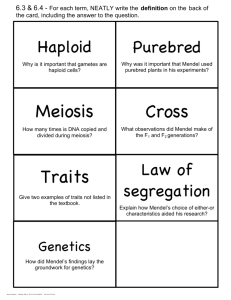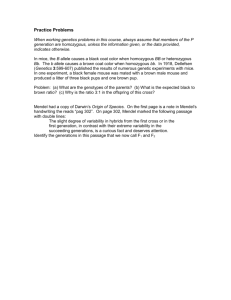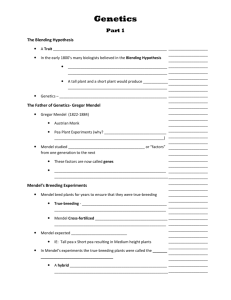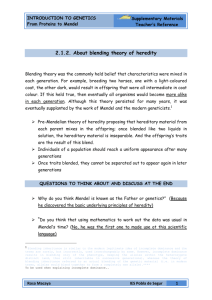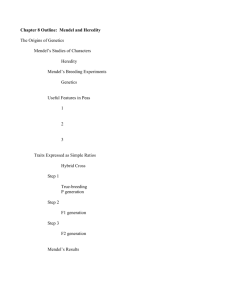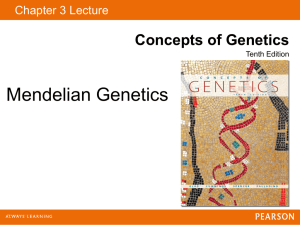Student's worksheets
advertisement
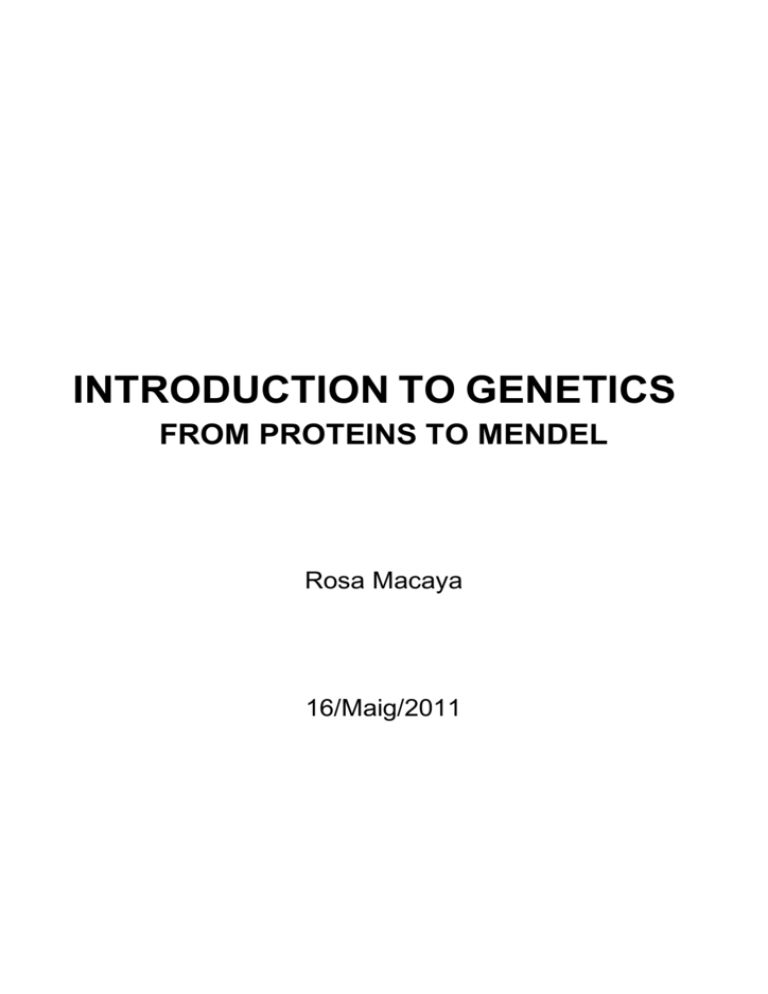
INTRODUCTION TO GENETICS FROM PROTEINS TO MENDEL Rosa Macaya 16/Maig/2011 INTRODUCTION TO GENETICS From Proteins to Mendel Student worksheets Unit 1 Lesson 1.1. Should we have our four child? Activity 1.1. I. Listen to the story and tick the words you hear HAPPINESS TEA INFUSION UNHAPPINESS BLOOD TRANSFUSION BLOODINFUSION BAD LUCK GOOD LUCK BLOODY BLEEDING PARENTS GRANDPARENTS OLDEST DEAD Rosa Macaya UNLUCKY ELDEST ALIVE IES Pobla de Segur 2 INTRODUCTION TO GENETICS From Proteins to Mendel Student worksheets Unit 1 Lesson 1.1. Should we have our four child? II. Listen to the story and take notes to draw a family tree. Male Female Listen to the story and try to find out what the problem is. I think that………….. It could be………….. Rosa Macaya IES Pobla de Segur 3 INTRODUCTION TO GENETICS From Proteins to Mendel Student worksheets Unit 1 Lesson 1.1. Should we have our four child? Activity 1.2 1.2.1. Listen to the story and find out the missing words. The words given in activity 1.1. will help you Should we have a fourth Should we child??? have a fourth child??? When I was young I______ dreamt about having children. I’d never thought that anything bad could happen to me. Even though my brother’s ____. He was really ________. Yes, he always had bad luck… My parents suffered so much; it was tough having to think about every little thing that Paul did. They couldn’t live in peace all his life. Phone calls from the school saying he was ________. Mum running to take him to hospital, _____ _________ plus all day-to-day stuff. It was all quite normal to me. I grew up with all of this. But, even so, I did not expect something like this to happen to me, to my children. Nobody told me that, nobody asked when I first got pregnant. There was _________ all around, even from my _______. They were so excited about becoming ____________; they didn’t tell me that there was any possibility of there being any problem with my child. But they didn’t tell me because they did not know the truth about their own son. Poor Paul. He died years ago from AIDS, something to be ashamed of. It wasn’t Paul’s fault. Poor Paul… all his short life affected by what he had inherited. He didn’t choose to die; death found him… got into somebody’s _____. Yes, somebody’s blood. How unlucky was that! Poor Paul… But nobody told me that my own kids could have the same problem as my ______ brother, my beloved brother. Not even the doctors told me anything. They didn’t ask me about my family __________. (Part I (1’46’’)28 lines) Rosa Macaya IES Pobla de Segur 4 INTRODUCTION TO GENETICS From Proteins to Mendel Student worksheets Unit 1 Lesson 1.1. Should we have our four child? 1.2.2 Listen to the story. Fill in the gaps and complete the family tree you drew in activity 1.1 So I had my _____ _____. We all felt so happy. And my ______, the lovely _____, and no problem either. But our luck seemed to run out when my ________ ___ was born. Just arrived in the world and he started to suffer. His birth was very traumatic. I lost a lot of blood, hours and hours and my poor baby was still bleeding. My ______ prayed. I was scared; I could not see him until days later. My _______ could, but he didn’t tell me anything. Well, I don’t think he knew what to say. When our son was diagnosed with “haemophilia” I didn’t know what it meant. In hospital we were asked about our family background and then I discovered the truth about ____. I couldn’t understand why my _______ hadn’t told me the truth about Paul’s illness, even about his death. But I don’t think they were sure about anything. I feel sorry for them now, but then I was very disappointed and I blamed them for my baby’s disease. If had known about this before, then certainly I wouldn’t have had the kid. But we did not know anything! (Part II, (1’13’’)15 lines) 1.2.3 Listen to the story. Fill in the gaps and write two sentences summarising the story. It took a while for us to understand ___________. With a lot of help from all the hospital staff we learnt to cope with it and how to bring up our ___________ child. Things have changed a lot, new products have been discovered and I hope my youngest child’s life will be easier than his uncle’s. Now, our Tom is already 6 years old and he seems to be controlling his ________ episodes. I don’t know if I am a _______ or not. Neither does my husband. Though everything points to the ____ coming from my family. I have learnt a lot about ___________. If only my parents had known more…, but I don’t think that it was their fault. They didn’t know anything and the doctors didn’t tell them Rosa Macaya IES Pobla de Segur 5 INTRODUCTION TO GENETICS From Proteins to Mendel Student worksheets Unit 1 Lesson 1.1. Should we have our four child? anything; they probably thought they wouldn’t understand. It is pity to live in such ignorance! Always believing that life is a kind of fate… But I don’t want to live like that. I’d like to have a fourth child and I want to know what the chances are of having a “healthy” child in spite of my ____ history. I have heard about being able to find out, but I am not sure. Science should be there to help to fight against our “bad” _____, shouldn’t it? (Part III, (1’15’’) 19 lines) Rosa Macaya IES Pobla de Segur 6 INTRODUCTION TO GENETICS From Proteins to Mendel Student worksheets Unit 1 Lesson 1.1. Should we have our four child? SHOULD WE HAVE A FOURTH CHILD??? When I was young I always dreamt about having children. I’d never thought that anything bad could happen to me. Even though my brother’s dead. He was really unlucky. Yes, he always had bad luck… My parents suffered so much; it was tough having to think about every little thing that Paul did. They couldn’t live in peace all his life. Phone calls from the school saying he was bleeding. Mum running to take him to hospital, blood infusions plus all day-to-day stuff. It was all quite normal to me. I grew up with all of this. But, even so, I did not expect something like this to happen to me, to my children. Nobody told me that, nobody asked when I first got pregnant. There was happiness all around, even from my parents. They were so excited about becoming grandparents; they didn’t tell me that there was any possibility of there being any problem with my child. But they didn’t tell me because they did not know the truth about their own son. Poor Paul. He died years ago from AIDS, something to be ashamed of. It wasn’t Paul’s fault. Poor Paul… all his short life affected by what he had inherited. He didn’t choose to die; death found him… got into somebody’s blood. Yes, somebody’s blood. How unlucky was that! Poor Paul… But nobody told me that my own kids could have the same problem as my eldest brother, my beloved brother. Not even the doctors told me anything. They didn’t ask me about my family background. So I had my first child. We all felt so happy. And my second, the lovely Helen, and no problem either. But our luck seemed to run out when my youngest son was born. Just arrived in the world and he started to suffer. His birth was very traumatic. I lost a lot of blood, hours and hours and my poor baby was still bleeding. My mother prayed. I was scared; I could not see him until days later. My husband could, but he didn’t tell me anything. Well, I don’t think he knew what to say. When our son was diagnosed with “haemophilia” I didn’t know what it meant. In hospital we were asked about our family background and then I discovered the truth about Paul. I couldn’t understand why my parents hadn’t Rosa Macaya IES Pobla de Segur 7 INTRODUCTION TO GENETICS From Proteins to Mendel Student worksheets Unit 1 Lesson 1.1. Should we have our four child? told me the truth about Paul’s illness, even about his death. But I don’t think they were sure about anything. I feel sorry for them now, but then I was very disappointed and I blamed them for my baby’s disease. If had known about this before, then certainly I wouldn’t have had the kid. But we did not know anything! It took a while for us to understand haemophilia. With a lot of help from all the hospital staff we learnt to cope with it and how to bring up our haemophilic child. Things have changed a lot, new products have been discovered and I hope my youngest child’s life will be easier than his uncle’s. Now, our Tom is already 6 years old and he seems to be controlling his bleeding episodes. I don’t know if I am a carrier or not. Neither does my husband. Though everything points to the gene coming from my family. I have learnt a lot about haemophilia. If only my parents had known more…, but I don’t think that it was their fault. They didn’t know anything and the doctors didn’t tell them anything; they probably thought they wouldn’t understand. It is pity to live in such ignorance! Always believing that life is a kind of fate… But I don’t want to live like that. I’d like to have a fourth child and I want to know what the chances are of having a “healthy” child in spite of my gene history. I have heard about being able to find out, but I am not sure. Science should be there to help to fight against our “bad” genes, shouldn’t it? Rosa Macaya IES Pobla de Segur 8 INTRODUCTION TO GENETICS From Proteins to Mendel Student worksheets Unit 1 Lesson 1.1. Should we have our four child? Activity 1.2.1. Read the following text and put the names of the family member. Compare the information you have written on the pedigree chart in activity 1.1.1. Paint in a different colour the members with haemophilia. Mrs Ann Drinkwater, born Pennymann, is a 38 years old woman with a family history of haemophilia A. She had got a five years older brother, Paul, who died 10 years ago after getting AIDS from a contamined plasma infusion. She does not have further information about other members of her family. Mrs Drinkwater’s husband, John is 40 years old and there are not haemophilia traits in his family. They have three children, the eldest is 12 years old called Matthew, Helen is 10. Both of them are not haemophilic. The youngest, Tom is 6 years old and he is haemophilic. Ann and John Drinkwater would like to have a fourth child and they have applied to a Genetic Cabinet to know the probability of having another child with the disease and if there is a possibility to avoid 100% sure that the inheritance of the haemophilia using Genetic Therapy. Rosa Macaya IES Pobla de Segur 9 INTRODUCTION TO GENETICS From Proteins to Mendel Student worksheets Unit 1 Lesson 1.2. Making posters! Activity 1.2.2. Making a poster Information about Haemophilia • Causes Haemophilia is a sex-linked disorder. Its gene is in chromosome sexual X. Since males (XY) have only one X chromosome, so only one copy of the gene placed in this chromosome, if the gene is they will be affected with the disease. Females have two X chromosome (XX) only will have the disease when they have the gene in both (rare). The probability of a woman having the disease is very low, though possible. That would happen if both father and mother had the affected haemophilic gene. Frequently female are only carriers because this gene is recessive in front the normal gene. That is why the have the ability to pass the gene on to their offspring but are not affected with the illness themselves. • Types There are two types of haemophilia, A and B. Haemophilia A involves a mutation in the factor (protein) VIII blood clotting factor gene and haemophilia B involves a mutation in the factor IX blood clotting factor gene. Both mutations do not let the process of blood clotting happen, as it normally should. • Symptoms Include internal bleeding, blood in stool and urine, frequent nosebleeds, easy bruising, and bleeding into muscles and joints that leads to chronic arthritis; bleeding in the rain External bleeding could appears if the skins is broken by a scrape, cut or abrasion. • Therapy There is not cure for haemophilia; it can be controlled with regular injections of the deficient clotting factor, i.e., factor VIII in haemophilia A. In western countries, common standards of care fall into two categories: prophylaxis or ondemand. The first one involves the infusion of clotting factor in order to keep clotting levels sufficiently high to prevent spontaneous bleeding episodes. Ondemand treatment involves treating bleeding episodes once they arise. Rosa Macaya IES Pobla de Segur 10 INTRODUCTION TO GENETICS From Proteins to Mendel Student worksheets Unit 1 Lesson 1.2. Making posters! • Collateral problems related to haemophilia therapy As a direct result of the contamination of the blood supply in the late 1970’s and early 80’s with virologic agents such as HIV (Human Immunodeficiency Virus) and Hepatitis new methods were developed in the production of clotting factor products. The initial response was to heat treat (pasteurize) plasma-derived concentrate, followed by the development of monoclonal factor concentrates grown to inactivate any viral agents. More recently, recombinant factors products (which are typically cultured in Chinese hamster ovaries and involve little, if any contact with human plasma products) have become available and are widely used in wealthier western countries. These products are quite safe but also very expensive and not usually available in developing countries and sometimes are even difficult to find in developing countries. Rosa Macaya IES Pobla de Segur 11 INTRODUCTION TO GENETICS From Proteins to Mendel Student worksheets Unit 1 Lesson 1.2. Making posters! Information about AIDS • What does “AIDS” mean? AIDS stands for Acquired Immune Deficiency Syndrome: Acquired means you can get infected with it Immune Deficiency means a weakness in the body’s system that fights diseases. Syndrome means a group of health problems that make up a disease. • Causes AIDS is caused by a virus called HIV, the Human Immunodeficiency Virus. If you get infected with HIV, your body will try to fight the infection. It will make “antibodies,” special molecules to fight HIV. A blood test for HIV looks for these antibodies. If you have them in your blood, it means that you have HIV infection. People who have the HIV antibodies are called “HIV-Positive.” Fact Sheet 102 has more information on HIV testing. Being HIV-positive, or having HIV disease, is not the same as having AIDS. Many people are HIV-positive but don’t get sick for many years. As HIV disease continues, it slowly wears down the immune system. Viruses, parasites, fungi and bacteria that usually don’t cause any problems can make you very sick if your immune system is damaged. These are called “opportunistic infections.” See Fact Sheet 500 for an overview of opportunistic infections. • How do you get AIDS? You don’t actually “get” AIDS. You might get infected with HIV, and later you might develop AIDS. You can get infected with HIV from anyone who’s infected, even if they don’t look sick and even if they haven’t tested HIVpositive yet. The blood, vaginal fluid, semen, and breast milk of people Rosa Macaya IES Pobla de Segur 12 INTRODUCTION TO GENETICS From Proteins to Mendel Student worksheets Unit 1 Lesson 1.2. Making posters! infected with HIV has enough of the virus in it to infect other people. Most people get the HIV virus by: having sex with an infected person sharing a needle (shooting drugs) with someone who’s infected being born when their mother is infected, or drinking the breast milk of an infected womaN Getting an infusion of infected blood used to be a way people got AIDS, but now the blood supply is screened very carefully and the risk is extremely Rosa Macaya IES Pobla de Segur 13 INTRODUCTION TO GENETICS From Proteins to Mendel Student worksheets Unit 1 Lesson 1.3. Making live possible...from DNA to Proteins Review from Molecular Genetics Activity 1.3.1 Look at the following picture… “The Central Dogma of Molecular Biology: From DNA to RNA to Protein,, Rosa Macaya IES Pobla de Segur 14 INTRODUCTION TO GENETICS From Proteins to Mendel Student worksheets Unit 1 Lesson 1.3. Making live possible...from DNA to Proteins Now………… From the single DNA strand below, write the complementary 5’ .. t a c t a a c g t t t g t a c a a a c c g g a a a t t .. 3’ ............…………………………………………………………………………………………………………………. then write the mRNA mRNA 5’ ………………………………………………………………………………...................…………………… 3’ Look at the pictures below and write the correct name in each label Rosa Macaya IES Pobla de Segur 15 INTRODUCTION TO GENETICS From Proteins to Mendel Student worksheets Unit 1 Lesson 1.3. Making live possible...from DNA to Proteins And now……….. with the help of the Genetic Code Table, translate the RNA nucleotides’ sequence to a polypeptide sequence You have made a protein!!!! Rosa Macaya IES Pobla de Segur 16 INTRODUCTION TO GENETICS From Proteins to Mendel Student worksheets Unit 1 Lesson 1.3. Making live possible...from DNA to Proteins Activity 1.3.2 Mutations WHAT WILL HAPPEN IF…….. …….. we change a pair nucleotides from the DNA strand…. t a c t a a c g t t t g t a c a a a c c g g a a a t g c t . State a hypothesis saying what could happen if you write “aa” instead the “tt”. You can start the hypothesis… “If I write aa, in the place of “tt” then the mRNA will be “aa” and then ……………………………………….................................................................................................... Now think of a “way” to prove your hypothesis Write down the conclusion. If the nucleotides’ sequence change, ...................................................................... . ........................................................................................................................................... Now, try to do another mutation. In this case try to delete a pair nucleotides from the DNA strand……. Predict what will happen…. And prove it! Rosa Macaya IES Pobla de Segur 17 INTRODUCTION TO GENETICS From Proteins to Mendel Student worksheets Unit 1 Lesson 1.4. Once upon a time playing with pea plants Activity 1.3.2. Let’s SCIENTIFIC METHOD and to relate Haemophilia (lack of an appropriate protein) and inheritance (DNA). Let’s work all together to write a hypothesis about this relationship and all the steps to prove or reject our hypothesis!! We are going to follow all the steps from the scientific method: 1. Problem – (What are you trying to figure out? Write this in the form of a question.) 2. Hypothesis – (What do you think you are going to find out?) 3. Materials and procedure (List the materials you will use in the experiment.) 4. Results – What did you observe when you performed the experiment? 5. Conclusion – From what you observed, how would you answer your original question? Rosa Macaya IES Pobla de Segur 18 INTRODUCTION TO GENETICS From Proteins to Mendel Student worksheets Unit 1 Lesson 1.4. Once upon a time playing with pea plants Activity 1.4.1 a) First read your text and fill in the corresponding part of the table below. b) Make 3 people group (A,B&C), share the information from your text and fill the rest of the table. A Date of birth Father’s job Grandfather’s job Why did he have to stop studying? Where did he continue his studies? What did he do in Vienna? What plant did Mendel mainly work with? B What did he discover about tall plants? What did he discover about short plants? What resulted from crossing tall and short plants? How many plants did he use? How many years did it take? What was his first law called? What was his second law called? C How many basis laws of heredity did he uncover? Did he become famous in his life? Why (not)? When did he die? Rosa Macaya IES Pobla de Segur 19 INTRODUCTION TO GENETICS From Proteins to Mendel Student worksheets Unit 1 Lesson 1.4. Once upon a time playing with pea plants What happened in 1900? Rosa Macaya IES Pobla de Segur 20 INTRODUCTION TO GENETICS From Proteins to Mendel Student worksheets Unit 1 Lesson 1.4. Once upon a time playing with pea plants Activity 1.4.2. Testing the text Choose the correct option 1) Gregor Mendel was: a) an English gardener who grew pea plants b) an unknown Central European monk c) an early 20th century Dutch biologist who carried out genetics research 2) Which of the following statements is true about Mendel? a) His discoveries concerning genetic inheritance were accepted by the scientific community b) He believed that genetic traits of parents would usually blend in their children. c) He made statistical analysis in his breeding experiments 3) Mendel believed that the traits of the pea plants are determined by the: a) hereditary units or factors from both parents b) hereditary units or factors from one parent c) health of the plant during the pollination 4) Mendel discovered that: a) short plants produced only short offspring b) tall plants produced only tall offspring c) short plants produced both, tall and short offspring 5) Mendel's law of independent assortment states that: a) each pair of genes is inherited independently of all other pairs. b) each pair of genes is inherited dependently of all other pairs. c) only a gene is inherited independently of all other Rosa Macaya IES Pobla de Segur 21 INTRODUCTION TO GENETICS From Proteins to Mendel Unit 2 Student worksheets Lesson 2.2. Swimming with Mendel’s laws Activity 2.1.1. Hot seats One of you plays Mendel’s role. Ask “this” Mendel questions about his findings. Activity 2.1.2. Genetic world words a) Warming up! Find out 15 of 15 words were placed into the puzzle. R H G E S G E Y T N H W K J P D K N V T F P I J C E I W L U O U I Q Q E A T H D T D B K R U G R K Q R M R P N E O Q H E W J P K T G O A N H R M K G T W W S H J M F P G M O I Z Z Q V J F Z O J P A E G Z N A L F O R F S E E M I W Q Y A V I E S U O G Y Z O M O H G N I D D G M G S I S O T I M O T J I I E E L D I K I J W C U T R N R T L N S E S D K A F S Z E Z B O I E E H R E C E S S I V E Y I K H H H M B W E L T N I X H U G X I N I C S E R M V E L P CHROMOSOME DOMINANT EGG HETEROZYGOUS HOMOZYGOUS HYBRID MITOSIS Rosa Macaya OFFSPRING PURE RECESSIVE GAMETE GENE MEIOSIS SPERM TRAIT IES Pobla de Segur 22 INTRODUCTION TO GENETICS From Proteins to Mendel Student worksheets Unit 2 Lesson 2.2. Swimming with Mendel’s laws b) Definition Team Game Word Cards (SM): Look at the set of cards you have. Listen to the teacher and match the sentences teacher reads out and look for the suitable word from your set. When you found it hand up. c) Genetic Terminology Crossword Across 1 Opposite of recessive Down 2 Different form of a gene 4 Section of DNA 3 Opposite to pure-breeding 5 Rewriting DNA's message 4 Combination of alleles 7 The first cell 6 Proteins factory 9 Humans have 23 pairs 8 Appearance of an organism's trai (10 of 10 words were placed into the puzzle). Rosa Macaya Created by Puzzlemaker at DiscoveryEducation.com IES Pobla de Segur 23 INTRODUCTION TO GENETICS From Proteins to Mendel Student worksheets Unit 2 Lesson 2.2. Swimming with Mendel’s laws d) Fill in the gaps: choose the correct word 1. Gregor , the "father of genetics" (Mendel/Darwin) 2. The first generation is the offspring of a cross between parents that are pure for a given trait. (Hybrid/Heterozygous/Homozygous-pure) and recessiviness. (blending/dominance) 3. The principle of (phenotype/genotype) 4. The outward expression or appearance: 5. Cross that involves parents that differ in TWO traits. (dihybrid cross/ Monohybrid cross) (heredity/genetics) 6. The study of heredity: 7. An alternate form of a gene: 8. The Principle of (allele/factor) Assortment (dependent/independent) 9. Having non identical alleles (not pure; ex. Aa): (heterozygous/homozygous) 10. Having identical alleles (pure, ex. AA): (heterozygous/homozygous) 11. Square used to determine probability and results of cross: (Punnett/Mendel) 12.The allele that is masked or covered up by the dominant allele: (recessive/dominant) 13. The genetic make-up or an organism (Tt): (recessive/dominant) 14. A cross that involves ONE pair of contrasting traits: (test cross/ dihybrid cross) 15. The plants Mendel did his studies on: (pea plants/peas plants) 16. The likelihood that an event will happen: (probability/chance) 17. When neither allele is dominant (they are both expressed): (codominant/recessiviness) 18. Principle of states that alleles separate when gametes are formed.(segregation/separation) Rosa Macaya IES Pobla de Segur 24 INTRODUCTION TO GENETICS From Proteins to Mendel Student worksheets Unit 2 Lesson 2.2. Swimming with Mendel’s laws Activity 2.2.1. Simple Genetics Practice Exercises 1. For each genotype, indicate whether it is heterozygous (HE) or homozygous (HO) AA Ee Ii Mm Bb ff Jj nn Cc GG kk OO Dd HH Ll Pp 2. For each of the genotypes below, determine the phenotype. Purple flowers are dominant to white Brown eyes are dominant to blue eyes flowers PP ____________ BB ___________ Pp ____________ Bb ___________ pp ____________ bb ___________ Round seeds are dominant to wrinkled Short tails are recessive (long tails dominant) RR ____________ TT _______________ Rr ____________ Tt _______________ rr ____________ tt ________________ 3. For each phenotype, list the genotypes. (Remember to use the letter of the dominant trait) Straight hair is dominant to curly. Pointed heads are dominant to round heads. _______ straight ________ pointed _______ straight ________ pointed _______ curly ________ round Rosa Macaya IES Pobla de Segur 25 INTRODUCTION TO GENETICS From Proteins to Mendel Student worksheets Unit 2 Lesson 2.2. Swimming with Mendel’s laws 4. Set up the square for each of the crosses listed below. The trait being studied is round seeds (dominant) and wrinkled seeds (recessive) Rr x rr What percentage of the offspring will be round? What percentage of the Rr x Rr offspring will be round? What percentage of the RR x Rr offspring will be round? Practice with Crosses. 5. A TT (tall) plant is crossed with a tt (short plant).What percentage of the offspring will be tall? 6. A Tt plant is crossed with a Tt plant. What percentage of the offspring will be short? 7. A heterozygous round seeded plant (Rr) is crossed with a homozygous round seeded plant (RR). What percentage of the offspring will be homozygous (RR)? 8. A homozygous round seeded plant is crossed with a homozygous wrinkled seeded plant. What are the genotypes of the parents? What percentage of the offspring will also be homozygous? Rosa Macaya IES Pobla de Segur 26 INTRODUCTION TO GENETICS From Proteins to Mendel Student worksheets Unit 2 Lesson 2.2. Swimming with Mendel’s laws 9. In pea plants purple flowers are dominant to white flowers. If two white flowered plants are crossed, what percentage of their offspring will be white flowered? 10. A white flowered plant is crossed with a plant that is heterozygous for the trait. What percentage of the offspring will have purple flowers? 11. Two plants, both heterozygous for the gene that controls flower colour are crossed. What percentage of their offspring will have purple flowers? What percentage will have white flowers? 12. In guinea pigs, the allele for short hair is dominant. What genotype would a heterozygous short haired guinea pig have? What genotype would a pure breeding short haired guinea pig have? What genotype would a long haired guinea pig have? 13. Show the cross for a pure breeding short haired guinea pig and a long haired guinea pig Rosa Macaya IES Pobla de Segur 27 INTRODUCTION TO GENETICS From Proteins to Mendel Student worksheets Unit 2 Lesson 2.2. Swimming with Mendel’s laws Rosa Macaya IES Pobla de Segur 28 INTRODUCTION TO GENETICS From Proteins to Mendel Student worksheets Unit 2 Lesson 2.2. Swimming with Mendel’s laws What percentage of the offspring will have short hair? 14. Show the cross for two heterozygous guinea pigs. What percentage of the offspring will have short hair? What percentage of the offspring will have long hair? 15. Two short haired guinea pigs are mated several times. Out of 100 offspring, 25 of them have long hair. What are the probable genotypes of the parents? ___ x ___ Show the cross to prove it! Rosa Macaya IES Pobla de Segur 29 INTRODUCTION TO GENETICS From Proteins to Mendel Student worksheets Unit 2 Lesson 2.2. Swimming with Mendel’s laws Activity 2.2.2. Two traits genetics crosses In rabbits, grey hair is dominant to white hair. Also in rabbits, black eyes are dominant to red eyes GG = grey hair BB = black eyes These letters represent the Gg = grey hair Bb = black eyes genotypes of the rabbits: gg = white hair bb = red eyes 1. What are the phenotypes (descriptions) of rabbits that have the following genotypes? Ggbb _________________ ggBB ______________________ ggbb _________________ GgBb ______________________ 2. A male rabbit with the genotype GGbb is crossed with a female rabbit with the genotype ggBb the square is set up below. Fill it out and determine the phenotypes and proportions in the offspring. Gb Gb Gb Gb gB gB gb gb How many out of 16 have grey fur and black eyes? How many out of 16 have grey fur and red eyes? How many out of 16 have white fur and black eyes? Rosa Macaya IES Pobla de Segur 30 INTRODUCTION TO GENETICS From Proteins to Mendel Student worksheets Unit 2 Lesson 2.2. Swimming with Mendel’s laws How many out of 16 have white fur and red eyes? Rosa Macaya IES Pobla de Segur 31 INTRODUCTION TO GENETICS From Proteins to Mendel Student worksheets Unit 2 Lesson 2.2. Swimming with Mendel’s laws 3. A male rabbit has the genotype GgBb. Determine the gametes produced by this rabbit (the sperm would have these combinations of alleles) Hint: there are 4 combinations. 4. A female rabbit has the genotype ggBb. Determine the gamets (eggs) produced by this rabbit. 5. Use the gametes from 4 and 5 to set up the punnet square below. Put the female's gametes on the top and the male's gametes down the side. Then fill out the square and determine what kind of offspring would be produced from this cross and in what proportion. gB gb GB Gb gB gb Rosa Macaya IES Pobla de Segur 32 INTRODUCTION TO GENETICS From Proteins to Mendel Student worksheets Unit 2 Lesson 2.3. Swinging with Mendel’s laws exceptions Activity 2.3.1 Co-dominance, Intermediate Expression and Multiple Allele If there are only two alleles involved in determining the phenotype of a certain trait, but there are three possible phenotypes, then the inheritance of the trait illustrates either incomplete dominance or codominance. The incomplete dominance is also known as intermediate expression, and the phenotype is shown as a blend of the parental phenotypes. Codominance phenotype shows both traits, ie. From a black and white, the offspring phenotype is black with white spots. 1. Practice setting up keys for the phenotypes listed in each set. Remember that the "medium" trait must always be heterozygous. a) Birds can be blue, white, or white with dark-blue feathers. b) Flowers can be white, pink, or red. c) A can have curly hair, spiked hair, or a mix of both curly and spiked. d) A e) A Rosa Macaya can be tall, medium, or short. can be spotted, black, or white. IES Pobla de Segur 33 INTRODUCTION TO GENETICS From Proteins to Mendel Student worksheets Unit 2 Lesson 2.3. Swinging with Mendel’s laws exceptions 2. Now, can you figure out in the above list, which of the examples represent codominant traits and which are incomplete. When there are 4 or more possible phenotypes for a trait, then more than 2 alleles for that trait must exist in the population but individuals have only two of those alleles. That happens because individuals have only two biological parents. We inherit half of our genes (alleles) from the mother and the other half from the father, so we cannot have more tan two alleles for every trait in our phenotype. An example of multiple allele inheritance is human blood type. Blood type exists as four possible phenotypes: A, B, AB, and O. there are 3 alleles for the gene that determines blood type. The allele for O (i) is recessive to the alleles for A and B. The alleles for A and B are codominant. The alleles are noted as i, IA and IB 3. Mrs. Drinkwater is blood type A and her mother is 0. Her children are o, B and A. Find out what Mr Drinkwater’s blood group could be. Rosa Macaya IES Pobla de Segur 34 INTRODUCTION TO GENETICS From Proteins to Mendel Student worksheets Unit 2 Lesson 2.3. Swinging with Mendel’s laws exceptions Activity 2.2.3. Genetics of Sex Determination In humans the genetic determination of sexual identity involves chromosomes. Humans have 46 chromosomes, 44 of these chromosomes pair together to make 22 pairs of homologous chromosomes (autosomes); the other 2 chromosomes are different, because they are involved in determining the sex. They are called sex chromosomes (XX/XY). Males have an X and a Y chromosome (XY), and females have two X chromosomes (XX). It is known that it is the presence of the Y chromosome that makes the individual male. Your knowledge of meiosis and fertilization provides the basis for understanding the inheritance of X and Y chromosomes. During meiosis in a female, the two X-chromosomes separate, so each egg has a single Xchromosome. In males, even though the X and the Y-chromosomes are very different, they can nevertheless pair with each other and separate from each other during meiosis. This means that males produce two kinds of sperm; half have an X chromosome and half have a Y chromosome. a) What will be the sex of a child produced when an egg is fertilized by a sperm that has a Y chromosome? What type of sperm must fertilize an egg to result in a female child? b) Draw a Punnett Square which shows the inheritance of the sex chromosomes. Use X to indicate an egg or sperm with an X chromosome and Y to indicate a sperm with a Y chromosome. Rosa Macaya IES Pobla de Segur 35 INTRODUCTION TO GENETICS From Proteins to Mendel Student worksheets Unit 2 Lesson 2.3. Swinging with Mendel’s laws exceptions c) Based on this Punnett Square, what percent of children would you expect to be male? Rosa Macaya IES Pobla de Segur 36 INTRODUCTION TO GENETICS From Proteins to Mendel Student worksheets Unit 2 Lesson 2.4. Let’s have children!...and something else Activity 2.2.4. Sex-linked Traits In humans, the X chromosome carries some genes that are not found in the Y chromosome. Inheritance of the phenotypic traits determined by the genes located in these chromosomes is therefore linked to the sex of the person. The X chromosome carries other genes which are not associated with determination of sex. One of these genes codes for a protein called blood clotting factor. Mutations can occur in this gene resulting in a blood protein that cannot clot the blood properly. This disease is known as haemophilia. Haemophilia Notation: XH chromosome with normal clot factor and Xh In humans, haemophilia is a sex linked trait. Females can be normal, carriers, or have the disease. Males will either have the disease or not (but they won’t ever be carriers) Female normal: XHXH Female carrier: XhX Female haemophiliac: XhXh Male normal: XY Male haemophiliac: XhY Show the cross of a man who has haemophilia with a woman who is a carrier. Draw the cross in the Punnett square. Rosa Macaya IES Pobla de Segur 37 INTRODUCTION TO GENETICS From Proteins to Mendel Student worksheets Unit 2 Lesson 2.4. Let’s have children!...and something else What is the probability that their children will have the disease? A woman who is a carrier marries a normal man. Show the cross. What is the probability that their children will have haemophilia? What sex will a child in the family with haemophilia be? A woman who has haemophilia marries a normal man. How many of their children will have haemophilia, and what is their sex? Rosa Macaya IES Pobla de Segur 38 INTRODUCTION TO GENETICS From Proteins to Mendel Student worksheets Unit 2 Lesson 2.4. Let’s have children!...and something else Activity 2.4.1. LET’S HAVE CHILDREN! What will our children look like? Your teacher will give you an envelope with a set of 4 X 2 chromosomes. The chromosomes are in different colours and present different alleles. Look at the chromosomes you have and fill in the chart with your phenotype and genotype. Simulate meiosis by tossing a coin. If heads, take chromosome X, if tails chromosome X‘. Now work with your partner and take your simple chromosome and match it with your partner’s simple chromosome. You both have your first child. Read and write your child’s phenotype and genotype. Repeat the process three or four more times. Activity 2.4.2. Genetic Report Work in groups of 3-4 students. Each group should write a genetic report for the Drinkwater family. Find out the information needed and write it down in the table. Rosa Macaya IES Pobla de Segur 39 INTRODUCTION TO GENETICS From Proteins to Mendel Student worksheets Unit 2 Lesson 2.4. Let’s have children!...and something else Mr & Mrs. Drinkwater: Genetic Report Part I: The Drinkwater Family’s pedigree. Part II: The Drinkwater Family's Haemophilia Part III: Information about Haemophilia To finish the report: You will be divided into two groups: the Drinkwaters and the Geneticists. Rosa Macaya IES Pobla de Segur 40 INTRODUCTION TO GENETICS From Proteins to Mendel Student worksheets Unit 2 Lesson 2.4. Let’s have children!...and something else Your aim is to answer Mrs Drinkwater’s question. (Key: As “geneticists and applying all you know about genetics find out possible solutions to have a child not suffering from haemophilia in order to tell the Drinkwaters) Final activity Role Play game: Let’s discuss! You will be divided into two groups to discuss the use of biotechnology in society, the ethical/moral implications of their use, etc… One group is FOR the use of biotechnology, the other AGAINST. First, work in your group to decide on why you are for or against (remember, these don’t have to be your real opinions). Make some notes. Now, as a whole class, you will have a debate. Do not be afraid to express your opinion and try to argue or justify it. Each group will choose a secretary which will summarize your opinions. When the discussion is over write them in the Venn Diagram below: Rosa Macaya IES Pobla de Segur 41
